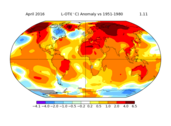European Heat Wave 2003
More than 70,000 people died during a record-breaking heat wave that left Europe sweltering in June, July and August 2003. In the first quantitative climate change attribution assessment, researchers found that human influence at least doubled the risk of a heatwave exceeding the threshold passed during the extreme European heat wave of 2003.[1] The study also finds that climate change made such an extreme heat event 4 times as likely.[1]
The period of extreme heat is thought to be the warmest for up to 500 years, and many European countries experienced their highest temperatures on record. One of the clearest findings of climate science is that heat waves are becoming more common, more intense and longer as a result of global warming. Heat waves today are already happening in a world that is 1.5°F (0.85°C) warmer than at the beginning of the 20th century. Warming has also influenced the way that weather patterns, including those that usher in heat waves, behave.







The historic 2003 European heat wave
One of the clearest findings of climate science is that heat waves are becoming more common, more intense and longer as a result of global warming. The European heat wave during the summer of 2003 is considered to be one of the major climate anomalies in recent times. From June 2003 through mid-August, temperatures in Europe were 20 to 30 percent higher than the seasonal average over a large portion of the continent, extending from northern Spain to the Czech Republic, from Germany to Italy.[1] It produced record-breaking temperatures in many cities of central-western Europe, including a record of 38°C in London, 39°C in Milan and 42°C in Paris.[2]
The heat wave caused tragic deaths of more than 70,000 people[3] and was responsible for many catastrophic socio-economic impacts, including enormous crop losses, forest fires and widespread persistent power losses.
In a July 2016 study, scientists specified the number of deaths during the heat wave in Paris and London specifically attributable to climate change.[4] They calculate that in Paris, the hottest city in Europe during the heat wave, 506 out of 735 summer deaths recorded in the French capital were due to a heat wave made worse by human-caused climate change. The impact of climate change was less severe in London, with an additional 64 deaths out of a total of 315 heat-related deaths.
Climate change may be increasing the frequency of atmospheric blocking events
The immediate cause of the extreme and unprecedented weather was a high pressure system that remained stagnant over the region, blocked by two areas of low pressure (what is known as atmospheric blocking).
A 2012 study identifies an eastward shift of blocking events over the North Atlantic (fewer cases of blocking over Greenland and more frequent blocking over the eastern North Atlantic) and the North Pacific.[5][6] A 2013 study finds an increase in blocking duration year-round over the Northern Hemisphere since about 1990.[7]
This European heat wave was the first of many
Since 2003, Europe has been affected by two notable heat waves in 2006 and 2015 that were caused by very similar meteorological conditions.[8]






